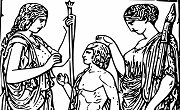CENTRAL Workshops 2019
Eight projects receive CENTRAL funding
In 2019 CENTRAL supports workshop activitites in eight different projects.
 Communicaton with the Underworld: From ancient Literature to Modern Children’s and Young Adult Literature
Communicaton with the Underworld: From ancient Literature to Modern Children’s and Young Adult Literature
Project Leader Humboldt-Universität: PD Dr. Darja Sterbenc-Erker
Partner: University of Vienna, University of Warsaw
The workshops will focus on ancient Roman and Greek communications with the underworld, and the reception of the underworld across such a variety of case-studies as Renaissance Latin (Petrarca), modern Irish and Caribbean literature, and in modern children’s and young adult literature. The aim of the workshops is to investigate ancient texts which uncover conceptions, representations and ideas of the underworld in antiquity that profoundly influenced modern European literature and, in fact, the entire European world. The joint research group will explore those ideas which have shaped the roots of modern European culture to propose new interpretations of ancient literature around communications with the underworld.
 Patterns of Liturgical Prescriptions. Data-driven Comparisons
Patterns of Liturgical Prescriptions. Data-driven Comparisons
Project Leader Humboldt-Universität: PD Dr. Tillmann Lohse
Partner: University of Warsaw, ELTE
Liturgical services in the Middle Ages must not be considered as restricted to a narrow interest of clerics, neither must they be treated as a special field of theological studies. On the contrary, in pre-modern Europe liturgy was present in almost all the aspects of the everyday life of both the clergy and the laymen. It was the means by which the highest percentage of intellectual and artistic achievements was communicated to the broadest audience and the most prestigious aim such achievements tended towards.
From the perspective of the formation of local, regional and institutional identities of pre-modern Europe, the variation of liturgical usages is of utmost significance and one of the most informative resources for mapping the patterns of such identities. Since earlier liturgical research concentrated on the archaic information, transmitted by sources composed before the first millennium, the traditions of the north-eastern parts of Latin Christendom were less frequented topics of scholarship. However, the practices of these neglected areas can only be interpreted in the widest possible context which demands a large-scale collection and analysis of evidence from all over Europe.
The arrangement of such an amount of information is facilitated by the upcoming approaches of digital humanities, especially database building and the encoding of texts. Therefore, the workshop aims to bring together four hitherto rather isolated fields of research: liturgical studies, manuscript studies, history of knowledge and digital humanities. The goal of the planned collaboration is to discuss how medieval norm texts can contribute to current issues of digital knowledge-management, with a special respect to liturgical traditions from Saxony, Poland and Hungary.
 Relatives, interrogatives, and alternatives
Relatives, interrogatives, and alternatives
Project Leader Humboldt-Universität: Dr. Radek Simik
Partner: University of Vienna, Charles University
The workshop aims to bring together senior and junior researchers dealing with one (or more) of the following research areas: the morphosyntax or semantics of relative clauses, wh-questions, and information structure. The central question of the workshop is why relative clauses are often identical to / derived from wh-questions (cf. Who came? and the man who came). Recent research has uncovered generalizations that suggest that the derivational relation from interrogatives to relatives is reflected in all areas of grammar and language development. No existing theory offers a satisfactory explanation of this problem. We therefore propose to convene a workshop devoted to further empirical investigations of the pertinent area as well as to the development of a new theory that would predict the observed recurrent linguistic pattern. The workshop will host experts and young scholars from Praha, Berlin, Vienna, and an invited speaker from Edinburgh. Building on a recently initiated collaboration, our aim is to strengthen the academic exchange between the universities involved and start developing a new international project that could support related work of young scholars.
 Law and Society in Times of Change: Theory and Praxis in Roman, Byzantine and Islamic Egypt
Law and Society in Times of Change: Theory and Praxis in Roman, Byzantine and Islamic Egypt
Project Leader Humboldt-Universität: Dr. Lajos Berkes
Partner: University of Warsaw, ELTE
The aim of the workshop is to find new and innovative ways to discuss the impact of regime changes on the implementation of law in the transition from Greek to Roman, and from Roman to Islamic Egypt. To attain this goal we will transcend traditional disciplinary boundaries and will draw on the experience of specialists of different fields such as legal history, classical philology, Papyrology, Egyptology and Ancient and Medieval history. We will focus on the times of change – administrative, governmental, and religious and how they affected the legal system. As a case study for the Eastern Mediterranean, we are going to focus on everyday documents from Greek, Roman, Byzantine, and Islamic Egypt preserved on papyrus which provide unique glimpses into the everyday realities of legal practice.
 Tracking down linguistic convergence. Contact languages in Eastern Central Europe
Tracking down linguistic convergence. Contact languages in Eastern Central Europe
Project Leader Humboldt-Universität: Dr. Uliana Yazhinova and Dr. Philipp Wasserscheidt
Partner: Charles University, University of Vienna
Some languages resemble each other strongly or at least in some respects. They may share certain words that are only slightly distinct in their pronunciation, or they may apply the same strategies to form new words. Some also resemble each other with respect to grammatical patterns, e.g. the way they form their future tenses. Most of these similarities result from the close genetic relation of the respective languages, like in the case of the Romance or the Germanic languages. However, also genetically non-related but neighbouring languages may share these above-mentioned features. If this is the case for more than two languages in a certain geographical area, linguists trace these similarities to language contact and say that the languages have converged and thus form a linguistic area (Germ. Sprachbund). This is the case for the languages in Eastern Central Europe and amongst them especially Czech, Slovak, Hungarian, and German (in Austria). So far, the research tradition has however not provided sufficient case studies to prove that the languages have become more similar through contact with each other. Additionally, it has neglected the probably most important aspect in language contact: the bilingual individual and their way of dealing with the languages and varieties in their repertoire in certain social settings. The planned workshops bring together scholars of several languages spoken in Eastern Central Europe as well as of Slavic languages, especially Russian as a heritage language. Their goal is to critically discuss and revise the idea of the Central European linguistic area. Therefore, they seek to integrate innovative theories and a mixed-methods approach to allow for the consideration of the bilingual individual and the sociolinguistic setting.
 Maps in Geography Textbooks
Maps in Geography Textbooks
Project Leader Humboldt-Universität: Prof. Dr. Dr. Péter Bagoly-Simó
Partner: ELTE, Charles University
Maps shape our daily life in myriad ways. They not only serve as means of orientation, but also influence the way we perceive space (e.g. dangerous, beautiful, contaminated, friendly spaces). Over the last decades, use of digital maps has become the standard. School Geography–to our knowledge–still introduces maps using analogue textbooks. There is no solid empirical evidence regarding teachers’ educational media choice connected to maps. Similarly, little is known about the educational media students use to acquire map skills. The three universities involved in this proposal build on pervious work
carried out in three national settings covering different aspects of textbook usage in context of maps. Mixed methods, including surveys and eye-tracking studies will help answer the main research questions. The two CENTRAL workshops will help the stakeholders to get ‘on the same page’ (or in this case ‘on the same map’) while updating the theoretical and methodological knowledge. In doing so, junior researchers will play a key role in initiating empirical work and publish the preliminary results in joint papers. This preparatory works serves as a starting point for research grant submission with the EC.
 Language and Cultural Comparison
Language and Cultural Comparison
Project Leader Humboldt-Universität: Dr. Rita Hegedüs
Partner: University of Warsaw, ELTE, Charles University, University of Vienna
In the pevious funding period a close and effective cooperation was developed between all CENTRAL partners. Teachers and doctoral students at the Hungarian departments
of the participating universities were envolved in the project. This cooperation is to be continued in two main directions:
A. Doing functional-typological work and promoting the metodology and theory of language teaching have already begun in the previous funding period. The goal is to create an expandable, multi-language online database built on a unified concept. Each chapter is a rich source for how a functional-discourse item operates in a language under concerned. Beyond the traditional components in language description the semantic-lexical and pragmatic aspects are also included. This is the way, how languages with different origin and typlogy will be accessible more easily, and the process of language learning, teaching and translation is facilitated and accelerated at the same time.
B. Exploring the cultural roots of the region, analyzing the connnections and interactions
between cultures, describing the reception of Hungarian culture in the different countries
offer a broader perspective to the students through lively and continuous scientific
debate . Specific topics in this field will be the reception of contemporary writers in the
different countries and the image of the countries in contemporary and older literature.
Comparing translations connects the literary and cultural aspect with the functional discourse manifestations in the language.
 Queer Theory and Literary Studies
Queer Theory and Literary Studies
Project Leader Humboldt-Universität: Prof. Dr. Eveline Kilian
Partner: University of Warsaw, University of Vienna
Queer theory has had a strong impact on the study of gender and sexuality since the 1990s. Its main focus is the deconstruction of the binary gender system and heteronormativity as well as a trenchant critique of all kinds of identity politics and identitarian logics. Queer has emerged as a critical force that undermines normative structures and explores and foregrounds those aspects which are excluded by such structures. After more than two decades, queer itself has undergone a number of modifications and repositionings, boundary-crossings and redrawings of boundaries. One notable de-velopment has been, for example, a more sustained rethinking of queer in terms of intersectionality.
Queer has also left its traces in literary studies, as can be seen in the numerous analyses of texts through the lens of queer theory. The resulting array of rather diverse investigations are loosely classed as ‘queer readings’, a term predominantly but not exclusively connected with the literary and queer scholar Eve Kosofsky Sedgwick, who has presented both incisive readings of individual texts and groundbreaking reflections on the epistemological potential of such readings. The aim of our series of workshops is to explore the different facets of queer theory that can be made productive for the study of literature.
Furthermore, in our project the various disciplinary affiliations of the participants as well as their different national and local contexts enter into the discussion as a major force of questioning and putting into perspective the quasi-natural and almost exclusive referencing of US-American sources in queer studies. This continues to trigger critical reflections on the implications of various local engagements with queer theory.
